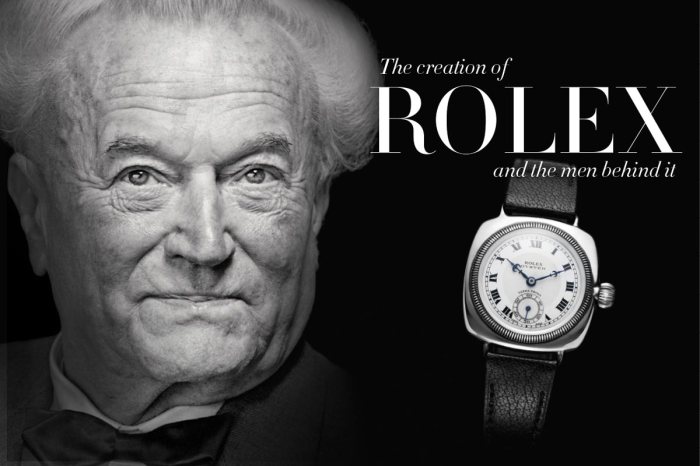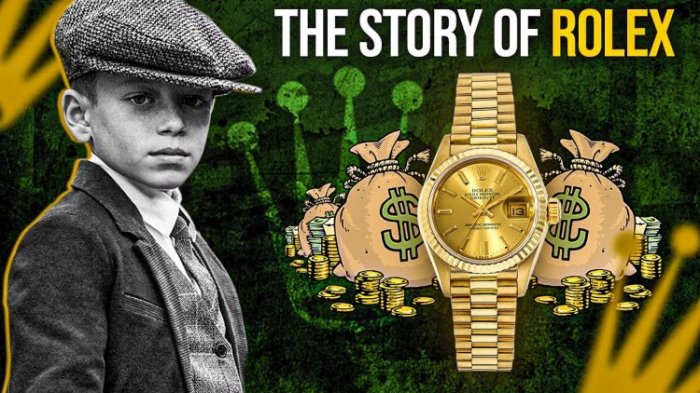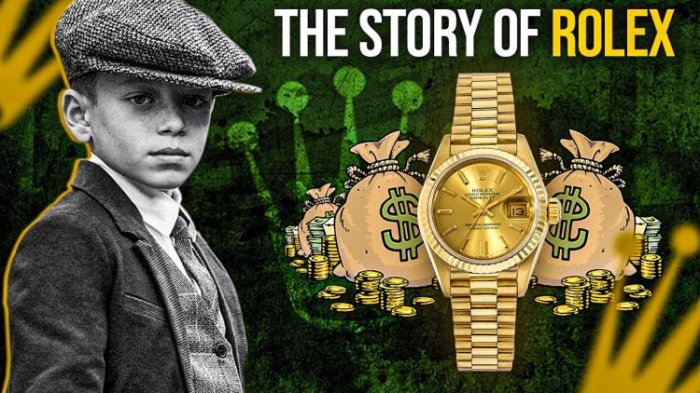From humble beginnings as an orphan, Hans Wilsdorf rose to become a legend in the world of luxury watches. His story is one of grit, determination, and an unwavering passion for precision. Wilsdorf’s journey, starting in the early 20th century, saw him navigate the turbulent waters of the watchmaking industry, eventually creating a brand that would become synonymous with quality, status, and timeless elegance: Rolex.
This isn’t just a story about a successful businessman; it’s a tale of innovation, driven by a relentless pursuit of perfection. Wilsdorf’s early life, marked by hardship, shaped his entrepreneurial spirit. He saw a gap in the market, a demand for watches that were not only accurate but also resistant to the elements, and he set out to fulfill it.
His vision, coupled with his unwavering dedication to craftsmanship, transformed the watch from a mere timekeeping device into a symbol of achievement and success.
Hans Wilsdorf and the Birth of Rolex
Hans Wilsdorf, the man behind the iconic Rolex brand, wasn’t born with a silver spoon in his mouth. His journey to becoming a watchmaking legend was paved with grit, determination, and a knack for recognizing opportunity. This is the story of a young man who dared to dream big and revolutionized the way the world perceived time.
Early Life and Entrepreneurial Spirit
Hans Wilsdorf was born in 1881 in Kulmbach, Germany. He wasn’t born into a wealthy family, but his parents instilled in him a strong work ethic and a thirst for knowledge. At a young age, Wilsdorf displayed a keen interest in business and mechanics.
He left home at 18 to pursue his dreams in London, where he worked as a clerk in a watch trading company. This experience gave him valuable insights into the world of watches and the burgeoning market for luxury timepieces.
Early Ventures and Challenges
Wilsdorf’s entrepreneurial spirit soon took flight. In 1905, he started his own company, “Wilsdorf & Davis,” with his brother-in-law, Alfred Davis. They began importing high-quality Swiss watches into England. Their initial focus was on affordable, pocket watches, but Wilsdorf had a vision for something more.
He envisioned a watch that was not only precise but also stylish and durable, a watch that could withstand the rigors of everyday life.
The Inspiration Behind “Rolex”
The name “Rolex” is a fascinating tale of innovation and branding. Wilsdorf was looking for a name that was short, easy to remember, and sounded good in multiple languages. He considered numerous options before settling on “Rolex.” The origin of the name remains somewhat of a mystery, but there are two popular theories:
- The name “Rolex” is a combination of the French words “horloge” (clock) and “ex” (excellent), signifying a watch of exceptional quality.
- Wilsdorf simply liked the sound of the name and felt it conveyed the brand’s elegance and sophistication.
Whichever theory is true, “Rolex” became synonymous with luxury and precision, a brand that would go on to become one of the most recognizable and respected in the world.
The Orphan Boy’s Vision

Hans Wilsdorf, the orphan boy who dreamt of a watch that would conquer the world, possessed an unyielding vision for precision and innovation. He wasn’t content with the status quo of watchmaking, he aimed for something more, something groundbreaking. His ambition wasn’t just about telling time; it was about creating a watch that embodied the pinnacle of human craftsmanship and engineering.
The Dawn of Precision: Early Rolex Models
Wilsdorf’s pursuit of precision began with the creation of the first Rolex models, which revolutionized the watchmaking industry. These early watches weren’t just about telling time accurately; they were about pushing the boundaries of what a watch could achieve.
You know that Rolex watch you’re rockin’? Yeah, that was the brainchild of an orphan boy who hustled his way to the top. Want to hear the full story of Hans Wilsdorf and his journey to luxury watchmaking? Download And Listen Here to get the full scoop on how he built an empire from nothing.
It’s a classic tale of hard work and determination, just like the timepieces he created.
- The Rolex Oyster (1926):This groundbreaking model introduced the world to the first waterproof wristwatch. The Oyster’s innovative design, featuring a sealed case and a winding crown, made it resistant to water and dust, a feat previously considered impossible. The Oyster, in its early iterations, showcased the revolutionary concept of a sealed case that protected the watch’s inner workings from the elements.
This innovation marked a significant turning point in the history of watchmaking. The Oyster’s waterproof and dustproof design ensured that the watch remained accurate and functional even in the harshest conditions, making it ideal for adventurers, explorers, and anyone who demanded a reliable timepiece.
This was a pivotal moment in Rolex’s journey to establish itself as a leader in the watchmaking industry.
- The Rolex Prince (1928):This elegant watch was the first to feature a self-winding mechanism, a revolutionary technology that eliminated the need for manual winding. The Prince, with its self-winding mechanism, offered a seamless and effortless experience for the wearer. The watch’s internal rotor, driven by the wearer’s movements, automatically wound the mainspring, ensuring that the watch always remained powered.
This invention further solidified Rolex’s commitment to innovation and redefined the standards of watchmaking. The Prince’s self-winding mechanism, a marvel of engineering, made it a true testament to Wilsdorf’s vision for precision and innovation.
- The Rolex Datejust (1945):This iconic model was the first wristwatch to feature a date window, a feature that became synonymous with Rolex. The Datejust’s elegant design, combined with its innovative date display, cemented its status as a symbol of luxury and sophistication.
The Datejust, with its seamless integration of the date window into the watch’s dial, further enhanced its functionality and appeal. This model, a masterpiece of both form and function, embodied the essence of Rolex’s commitment to excellence and innovation.
The Datejust, with its enduring popularity, has become a timeless classic and a testament to Wilsdorf’s vision for a watch that would transcend generations.
Rolex
The journey of Rolex, from its humble beginnings to its status as a global icon, is a testament to innovation, craftsmanship, and enduring appeal. It’s a story of an orphan boy’s vision and a legacy of excellence that has captured the imagination of generations.
You know how they say, “from rags to riches”? Well, Hans Wilsdorf, the orphan boy who created Rolex, totally embodies that. He was a hustler, a visionary, and a master of his craft. And speaking of crafts, check out this totally rad coloring book, Art Nouveau Birth Month Flower Coloring Book for Adults Grayscale Coloring Book 48 Grayscale Coloring Pages (Art Nouveau Flower Gardens) , with its intricate floral designs.
It’s like the Art Nouveau movement met a coloring book and had a love child. Anyway, back to Rolex, the brand is known for its high-quality watches, and Hans Wilsdorf’s story is definitely one for the ages.
Rolex: A Legacy of Excellence
The history of Rolex is marked by a series of groundbreaking innovations and milestones that have shaped the watchmaking industry and cemented its position as a symbol of prestige and performance.
- 1905:Hans Wilsdorf, the visionary founder of Rolex, establishes his watch import and distribution business in London, laying the foundation for the legendary brand.
- 1910:Wilsdorf registers the name “Rolex,” a name that embodies the brand’s commitment to quality and precision.
- 1914:Rolex receives its first official chronometer certification, a testament to the accuracy and reliability of its timepieces. This certification, a rigorous test of precision and performance, became a hallmark of Rolex watches and a symbol of their exceptional quality.
- 1926:Rolex unveils the world’s first waterproof wristwatch, the Oyster, revolutionizing the watchmaking industry and paving the way for future innovations. This breakthrough design, featuring a hermetically sealed case, ensured that the watch remained protected from water and dust, opening up new possibilities for wearability and durability.
- 1931:Rolex introduces the first self-winding wristwatch, the Perpetual, a significant technological advancement that eliminated the need for manual winding. The Perpetual, with its innovative rotor system, allowed the watch to be powered by the natural movement of the wearer’s wrist, making it more convenient and user-friendly.
- 1953:Sir Edmund Hillary and Tenzing Norgay conquer Mount Everest, wearing Rolex Oyster watches, proving the extraordinary resilience and reliability of the brand in extreme conditions. This legendary feat solidified the reputation of Rolex as a watch capable of withstanding the most demanding environments.
- 1960:Jacques Piccard and Don Walsh descend to the deepest point of the ocean, the Mariana Trench, with a Rolex Deep Sea Special watch strapped to the outside of their bathyscaphe, showcasing the watch’s exceptional depth-rating capabilities. This groundbreaking dive marked a significant milestone in human exploration and further cemented the brand’s reputation for durability and reliability.
- 1967:Rolex introduces the first chronometer wristwatch with a date display, the Datejust, adding a practical and elegant feature to its collection. The Datejust, with its distinctive cyclops lens magnifying the date, became a popular choice for both men and women, offering both functionality and style.
- 1980s:Rolex continues to expand its collection, introducing iconic models like the Yacht-Master, a watch designed for sailing enthusiasts, and the Explorer II, a watch with a 24-hour hand for adventurers and explorers. These additions further diversified the Rolex portfolio, catering to a wider range of individuals and their specific needs.
- 1990s:Rolex embraces the use of new materials and technologies, introducing the Sea-Dweller Deepsea, a watch capable of withstanding depths of 3,900 meters (12,800 feet), and the Cellini, a collection of elegant dress watches that showcase the brand’s expertise in fine watchmaking.
These advancements further reinforced Rolex’s commitment to pushing the boundaries of watchmaking and meeting the demands of a sophisticated clientele.
- 2000s:Rolex continues to innovate, introducing new models like the Sky-Dweller, a watch with a dual time zone function, and the Yacht-Master II, a watch with a regatta countdown timer, further solidifying its position as a leader in luxury watchmaking.
Notable Individuals and Cultural Impact
Rolex watches have adorned the wrists of some of the most influential and notable individuals throughout history, becoming synonymous with status, success, and achievement.
- Presidents:Rolex watches have been worn by presidents from various countries, including Dwight D. Eisenhower, John F. Kennedy, and Ronald Reagan, further solidifying their association with power and prestige.
- Actors:From Hollywood icons like Marlon Brando and Paul Newman to modern-day stars like Leonardo DiCaprio and Daniel Craig, Rolex watches have graced the wrists of some of the most celebrated actors in the world.
- Athletes:Rolex has a long-standing partnership with the world of sports, sponsoring major events like Wimbledon and Formula One, and partnering with renowned athletes like Roger Federer and Tiger Woods.
- Musicians:Rolex watches have been worn by legendary musicians like Elvis Presley, John Lennon, and Eric Clapton, further cementing their place in popular culture.
Enduring Appeal and Relevance
Rolex’s enduring appeal lies in its unwavering commitment to quality, craftsmanship, and innovation. Each watch is a testament to the brand’s dedication to excellence, reflecting its status as a symbol of timeless elegance, precision, and prestige.
- Timeless Design:Rolex watches are known for their classic and timeless designs, with many models remaining popular for decades. The brand’s iconic aesthetic, characterized by its distinctive features like the cyclops lens and the fluted bezel, has become instantly recognizable and highly sought-after.
- Exceptional Craftsmanship:Rolex watches are meticulously crafted by skilled artisans using the finest materials and techniques. Each watch undergoes rigorous testing and inspection, ensuring its accuracy, reliability, and durability.
- Innovation and Technology:Rolex continues to push the boundaries of watchmaking, constantly introducing new technologies and innovations to enhance its timepieces. From self-winding mechanisms to innovative materials and advanced complications, Rolex remains at the forefront of the watchmaking industry.
- Prestige and Status:Rolex watches are highly coveted and have become a symbol of success, achievement, and prestige. Their exclusivity and high value make them a desirable acquisition for individuals seeking to express their status and appreciation for fine craftsmanship.
- Investment Value:Rolex watches are known for their excellent investment value, with certain models appreciating significantly over time. Their enduring popularity and limited production ensure that they remain highly sought-after in the secondary market.
Book Review
The Orphan Boy Who Created Rolexis a captivating read that delves into the life and legacy of Hans Wilsdorf, the visionary behind the iconic watch brand. The book weaves together Wilsdorf’s personal journey, from his humble beginnings as an orphan to his rise as a global entrepreneur, with the evolution of Rolex, capturing the spirit of innovation and meticulous craftsmanship that defines the brand.
Cover Design
The book cover would feature a striking image of a vintage Rolex watch, its elegant design and intricate details highlighted against a backdrop of a classic cityscape. The title, “The Orphan Boy Who Created Rolex,” would be prominently displayed in bold, elegant font, suggesting a story of resilience and triumph.
The cover’s color palette would be rich and sophisticated, using tones of gold, black, and white to evoke the brand’s luxury and timeless appeal. The image of a young Hans Wilsdorf, with a determined look in his eyes, peering through a magnifying glass at a watch mechanism, could be subtly incorporated into the design, hinting at his early passion for horology and his unwavering pursuit of perfection.
Strengths and Weaknesses
The book’s strengths lie in its engaging narrative, which seamlessly blends historical facts with captivating anecdotes, offering a comprehensive look at Wilsdorf’s life and the rise of Rolex. The author meticulously researches and presents detailed information about the watchmaking process, the challenges Wilsdorf faced, and the innovative technologies he pioneered.
This meticulous approach provides readers with a deep understanding of the brand’s origins and its enduring legacy.
However, the book could benefit from a more balanced exploration of Wilsdorf’s personal life. While the narrative touches upon his relationships with his family and colleagues, it could delve deeper into his personal motivations, aspirations, and the impact of his successes and failures on his character.
Additionally, the book’s focus on the historical aspects of Rolex could be complemented by a more in-depth exploration of the brand’s cultural impact and its influence on the world of luxury watches.
You know how they say, “Life throws you lemons, make lemonade?” Well, Hans Wilsdorf, the orphan boy who created Rolex, took that saying to a whole new level. He started his watchmaking journey in a tiny shop, but with hustle and determination, built a brand that’s now synonymous with luxury.
His story reminds me of I Made Lemonade A Memoir Part Two , where the author talks about turning their own tough experiences into something positive. Just like Wilsdorf, they show that even with a rough start, you can create something truly amazing.
Marketing Strategy
Targeting a diverse audience, the book’s marketing strategy would leverage various promotional channels to reach potential readers.
The Orphan Boy Who Created Rolex, Hans Wilsdorf, was a visionary who saw the potential of precision engineering. His story echoes the ambition of Jensen Huang, the mastermind behind Nvidia, whose chips are literally processing the mind of artificial intelligence as we know it.
Just like Wilsdorf revolutionized timekeeping, Huang is changing the way we interact with technology, pushing the boundaries of what’s possible. And just as Rolex became a symbol of luxury and precision, Nvidia’s influence on AI is shaping the future of our world.
- Targeted Advertising:Online campaigns on platforms frequented by watch enthusiasts, history buffs, and individuals interested in biographies and business stories would effectively reach the target audience.
- Partnerships with Luxury Retailers:Collaborating with high-end watch retailers and luxury lifestyle publications would provide access to a discerning audience and create a sense of exclusivity.
- Social Media Engagement:Engaging with watch collectors and enthusiasts on platforms like Instagram and Twitter, showcasing excerpts, behind-the-scenes content, and expert insights would build anticipation and generate interest.
- Book Events and Author Appearances:Organizing book signings, talks, and discussions at watch fairs, museums, and cultural institutions would offer a platform for engaging directly with the target audience and building brand awareness.
Closing Summary

The story of Hans Wilsdorf and Rolex is a testament to the power of human ingenuity and the enduring allure of luxury. From the very beginning, Wilsdorf understood the importance of branding and marketing, positioning Rolex as a status symbol for the elite.
His vision, combined with a relentless pursuit of innovation, has ensured that Rolex remains a global icon, a brand that transcends time and continues to captivate the world with its timeless elegance and unmatched quality.
Essential FAQs
What makes Rolex watches so special?
Rolex watches are known for their exceptional precision, durability, and craftsmanship. They are built to withstand the most extreme conditions, from the depths of the ocean to the summit of Mount Everest. Rolex also uses the highest quality materials and employs meticulous manufacturing processes, ensuring that each watch is a masterpiece of engineering.
What are some of the most iconic Rolex models?
Some of the most iconic Rolex models include the Submariner, the Daytona, the GMT-Master, and the Datejust. These watches are not only known for their functionality but also for their distinctive designs, which have become synonymous with Rolex.
How did Rolex become such a successful brand?
Rolex’s success can be attributed to several factors, including its commitment to quality, its innovative design, and its effective marketing strategies. Rolex has always been associated with prestige and luxury, and its watches have been worn by some of the most famous people in the world.
This has helped to build the brand’s reputation and create a strong sense of desire among consumers.

